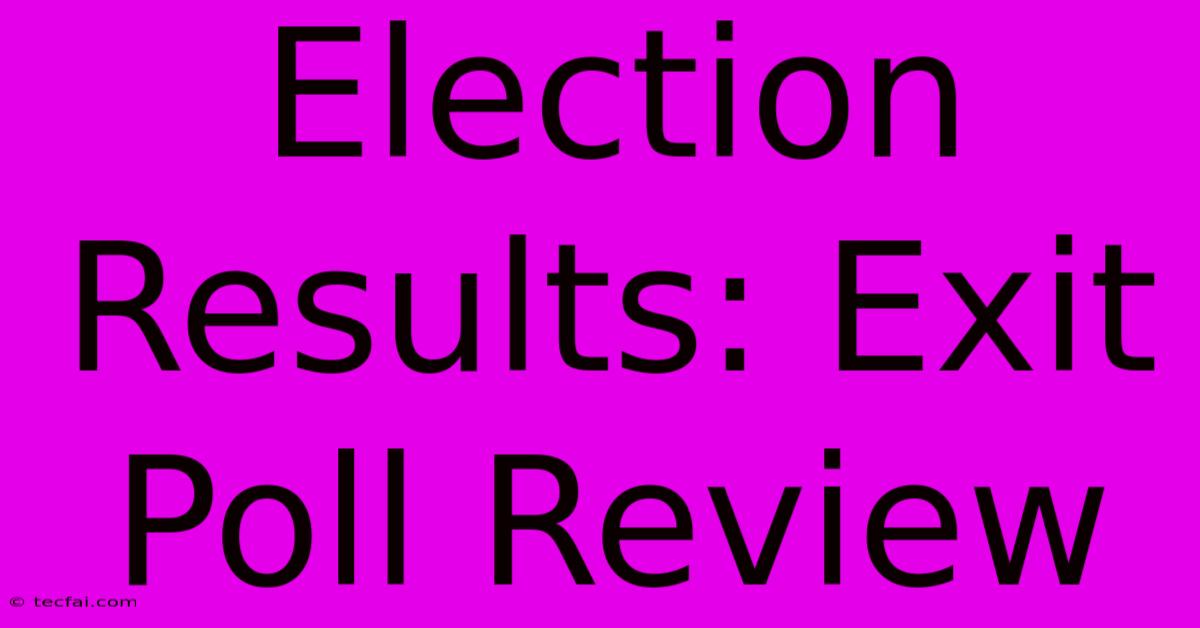Election Results: Exit Poll Review

Discover more detailed and exciting information on our website. Click the link below to start your adventure: Visit Best Website tecfai.com. Don't miss out!
Table of Contents
Election Results: Exit Poll Review – What They Got Right, and Where They Went Wrong
Exit polls, those quick snapshots of voter sentiment taken immediately after casting ballots, have become a staple of election coverage. They offer a tantalizing glimpse into the electorate's choices before official tallies are complete, creating both excitement and, sometimes, controversy. This article will delve into the accuracy and limitations of exit polls, examining recent elections to understand what they got right and where they fell short.
Understanding Exit Polls: Methodology and Limitations
Exit polls rely on a statistical sampling method. Surveyors stationed outside polling places randomly select voters to participate in brief questionnaires. These questionnaires typically cover voting choices, demographic information (age, race, gender, etc.), and key issue positions. The data is then extrapolated to project overall election outcomes.
However, the inherent limitations of this methodology are crucial to understanding their accuracy. Several factors can skew results:
Sampling Bias:
- Self-selection bias: Not all voters are willing to participate, potentially skewing the sample towards a particular demographic or viewpoint. Those who are more politically engaged or have stronger opinions might be more likely to participate.
- Geographic bias: The selection process might not perfectly represent the entire electorate's geographical distribution, leading to inaccurate projections in certain regions.
- Weighting adjustments: While statisticians use weighting techniques to adjust for sampling biases, these adjustments are not always perfect and can introduce their own errors.
Unpredictable Voter Behavior:
- Shy voters: Some individuals might be reluctant to admit their voting choice to a surveyor, particularly if it's unpopular in their immediate social circle. This "shy voter effect" can lead to inaccurate predictions.
- Last-minute decisions: Exit polls are conducted after voters have cast their ballots. However, voter decisions aren't always fixed until the last minute. Last-minute shifts in opinion cannot be captured by exit polls.
- Undecided voters: Exit polls struggle to accurately predict the behavior of undecided voters who may make up a significant portion of the electorate. Their final choice can dramatically impact the overall outcome.
Case Studies: Examining Recent Election Exit Polls
Analyzing specific election cycles helps highlight the strengths and weaknesses of exit polls. For example, in [Insert Recent Election Year], exit polls [mention specific successes and failures – e.g., accurately predicted the winner in State X but significantly underestimated the margin of victory in State Y]. This discrepancy could be attributed to [mention potential reasons – e.g., higher-than-expected turnout in State Y, or an underestimation of support for a particular candidate].
Similarly, the [Insert Another Recent Election Year] election saw exit polls [mention specific successes and failures, analyzing potential reasons for discrepancies]. The analysis of these examples helps illustrate how various factors like voter turnout, unexpected shifts in voter sentiment, and methodological limitations can impact the accuracy of exit poll predictions.
Beyond the Numbers: The Value of Exit Polls
Despite their limitations, exit polls provide valuable insights beyond just predicting election winners. They offer a rich dataset for understanding:
- Voter demographics: Exit polls reveal demographic trends, helping analysts understand which groups support particular candidates or parties.
- Issue positions: By analyzing responses on key issues, exit polls provide a sense of voter priorities and concerns.
- Campaign effectiveness: Examining the relationship between voter demographics and voting choices helps assess the success of different campaign strategies.
Conclusion: A Tool, Not a Crystal Ball
Exit polls should be viewed as a valuable tool for understanding voter behavior, not as a flawless predictor of election outcomes. Their inherent limitations, including sampling bias and unpredictable voter actions, must always be considered. By acknowledging these limitations and utilizing exit polls in conjunction with other data sources, we can gain a more nuanced understanding of the electoral landscape and the factors that shape election results. Remember to always treat exit poll data with a healthy dose of skepticism and critically analyze the results before drawing conclusions.

Thank you for visiting our website wich cover about Election Results: Exit Poll Review. We hope the information provided has been useful to you. Feel free to contact us if you have any questions or need further assistance. See you next time and dont miss to bookmark.
Featured Posts
-
Sophie Rain Out Earns A Listers
Nov 30, 2024
-
Nba Cup 2024 Timberwolves Vs Clippers
Nov 30, 2024
-
Penang Assemblyman Mali Ang Aking Paratang Kay Anwar
Nov 30, 2024
-
Irfu 150 Gala Dinner Event
Nov 30, 2024
-
Walmarts 25 Best Black Friday 2024 Deals
Nov 30, 2024
